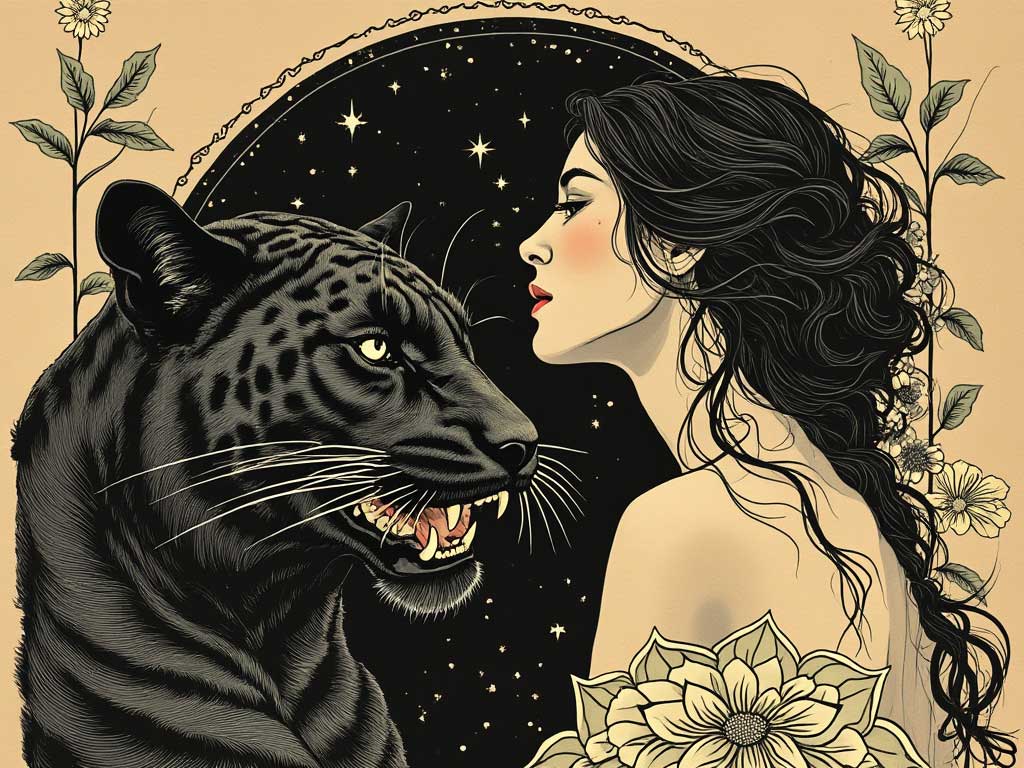Shamanism, Transformation, and the Power of Animal Spirits in relation to the movie The Cat People
In shamanic traditions worldwide, the ability to transform into an animal is not just a symbolic act—it represents a deep connection to the spiritual and natural realms. Transforming into an animal is seen as entering the energy field of that creature, embodying its instincts, wisdom, and power. The panther, in particular, holds profound significance in many indigenous cultures. It often symbolizes stealth, strength, and the mysteries of the unseen.
In the film The Cat People (1942, 1982}, the protagonist’s panther transformation could be interpreted as a metaphor for untamed human potential. However, her inability to control this power reflects a modern society that has lost touch with such primal forces. Where ancient shamans embraced and honed these abilities through discipline and ritual, the protagonist’s transformations are involuntary, triggered by passion and fear. This divergence underscores how modernity has distanced itself from practices that foster a symbiotic relationship with nature.
Freud’s Theories in the Context of Shamanism
Freud’s interpretations of animism and incestuous desires often reflect his reductionist approach to human psychology. His Oedipal theory, which centers on forbidden familial desires, is imposed onto animist traditions with little regard for their cultural contexts. Shamanic traditions, in contrast, often emphasize the dissolution of ego and personal desires to commune with higher spiritual realms.
In The Cat People (1982), the brother’s incestuous desire reflects Freud’s idea that isolation and “otherness” intensify forbidden attractions. Yet, Freud’s theories fail to account for the shamanic worldview, where transformations and connections with animal spirits are less about individual desires and more about service to the community and harmony with the natural world. The protagonist’s rejection of her brother’s advances and her preference for a caged existence could be seen as her rebellion against the Freudian framework, choosing suppression over surrender to taboo desires.
Sexuality and Civilization’s Constraints
The connection between the protagonist’s sexuality and her transformation reflects a broader commentary on civilization’s attempts to control and suppress human instinct. Sexuality, often associated with life force and creative energy, is viewed with suspicion in many cultures. Civilized society tends to define acceptable expressions of desire while labeling anything outside these norms as dangerous or deviant.
The protagonist’s panther transformations symbolize this conflict. Her animalistic side—a manifestation of raw, unbridled energy—is perceived as monstrous and incompatible with societal order. This mirrors broader cultural anxieties about the “wild” aspects of human nature. In many ways, her struggle reflects the experience of individuals whose sexual identities or behaviors deviate from societal expectations.
The Fate of Wildness in a Domesticated World
The film draws a poignant parallel between the protagonist’s plight and that of wild animals in the modern world. Big cats like panthers, once revered as apex predators and spiritual symbols, are now endangered, their habitats destroyed by human encroachment. In captivity, these animals are stripped of their freedom and vitality, reduced to objects of spectacle in zoos and circuses.
Similarly, the protagonist’s choice to live as a caged animal rather than embrace her shamanic identity reflects a broader existential crisis. In a world that devalues and confines wildness—whether in nature or within ourselves—what place is left for those who cannot conform? The film suggests that the “wild” is both feared and desired, a contradiction that reveals civilization’s uneasy relationship with its primal roots.

Shamanic Traditions and Transformation
While the film draws on shamanic motifs, it diverges significantly from authentic shamanic traditions. In shamanism, the ability to transform into an animal, whether a wolf, bear, or eagle, typically requires intense spiritual discipline, including practices like fasting, meditation, and often abstinence from sex. This abstinence conserves the vital energy required for such profound transformations.
In northern Scandinavia, for example, Lapp shamans are believed to transform into wolves, bears, or fish. Carlos Castaneda, a controversial anthropological writer, recounts becoming a crow through hallucinogenic rituals. Similarly, Don Genaro, a sorcerer figure in Castaneda’s works, discusses transformations into eagles and owls. Even in Renaissance Italy, Giovanni Battista Porta, a contemporary of Galileo, wrote Natural Magick, a treatise exploring alchemical methods for human-animal transformations.
These examples reflect the shamanic perspective that animal transformations are sacred acts requiring preparation and focus, not spontaneous occurrences triggered by sexual encounters.
The Shamanic Perspective on Identity and Otherness
Shamanic practices often blur the lines between human and animal, self and other, embodying a worldview that is inherently non-dualistic. In this tradition, transformation is not about becoming something entirely other but rather awakening to a deeper truth that has always been present. The panther is not separate from the shaman; it is a part of their spiritual essence.
In The Cat People, the protagonist’s struggle with her identity highlights how modern society fractures this unity. She sees her animal side as a curse, something to be feared and suppressed. This contrasts sharply with shamanic teachings, where the integration of human and animal consciousness is seen as a path to wisdom and wholeness.
A Cultural Lens on the Narrative
The film also invites us to consider how indigenous spiritual practices have been misrepresented or misunderstood in Western narratives. While The Cat People borrows shamanic imagery, it frames the transformation as a curse rather than a sacred gift. This reflects a colonial mindset that often exoticizes and distorts non-Western traditions.
By portraying the protagonist’s shamanic heritage as something monstrous, the film perpetuates the idea that the “wild” and “other” must be controlled or eradicated. This stands in contrast to authentic shamanic traditions, which celebrate the interconnectedness of all life and see the human-animal bond as a source of strength and wisdom.
